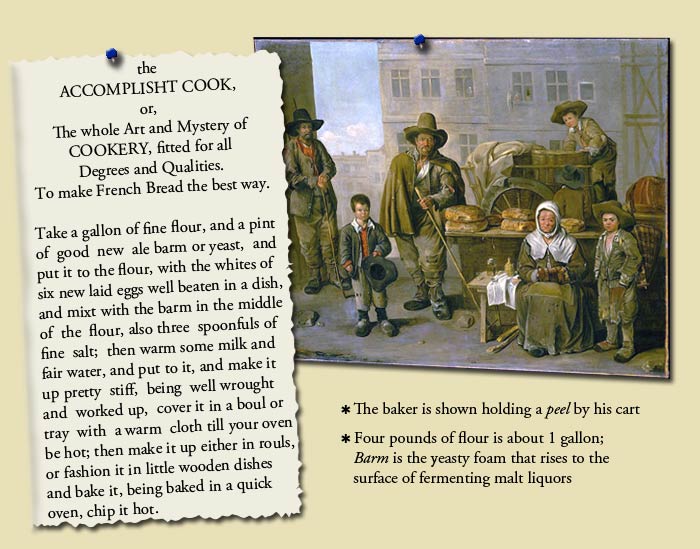Pierre Perras, Boulanger.
Starting a Family.
Pierre Perras and his wife Jeanne Lasnier lived in La Rochelle, France where they had at least had three children. The first, Marie, was baptized in the Catholic parish of Saint-Jean on 21 August 1612; our ancestor Pierre on 21 August 1616 and his sister Catherine on 07 October 1618 were baptized in chapelle Sainte-Marguerite. Pierre's godfather was Jean Gaigneur, procureur au siége prèsidial de La Rochelle. (A procureur was a prosecutor active in civil cases.)
Boulanger.

The Accomplisht Cook, first published in 1660, by Robert May at Project Gutenberg
In the Ancien Régime successful bakers, like other tradesmen, were members of a guild. The guilds safeguarded the secrets and mysteries of their crafts, regulated prices, the quality of the goods produced and controlled who could sell the wares. As can be imagined, tradesmen often found ways around the government regulations.
Pierre rose early in the day to stoke the wood fire. A hot or "quick" oven was required to bake the sourdough boule, a traditional round loaf of bread. He used a long wood peel to pull the baked goods in and out of the domed oven. Finely ground white wheat was used for pain mollett to make a 12 ounce bread for the "upper crust" that was described by Randall Cotgrave in 1611 as "a verie light, verie crustie, and savorie white bread, full of eyes, leaven, and salt." A run-of-the-mill bourgeoisie bread, much heavier, used a mixed of grains. The peasantry were left with pain bris baked from darker grains like rye or barley, often mixed with indigestible chaff or sawdust. But Bakers were no exception to finding a work around guild rules, developing petit pan or "small bread", a roll, to increase sales of their finer breads.
Pierre, fils.
Son Pierre was twelve years old during le siège de La Rochelle which began in 1627. Under Henri IV, who promoted religious tolerance, the port city of La Rochelle grew as a Huguenot stronghold. When the king was assassinated in 1610, his successor, Louis XIII's regent Marie de Médicis embraced a pro-Catholic posture, re-inflaming old rivalries. Thousands died as a result of the year-long blockade imposed on the city.
How the Catholic Perras family fared in the assault is unknown. Their son Pierre chose a different profession than his father, perhaps the bakery business was devastated. He is first mentioned in records in the New World in 1660 when he contracted to marry.
- Émigration rochelaise en nouvelle-france, p 184
- Jetté, René, Dictionnaire généalogique des familles du Quebec des origines à 1730 (Montréal: Les Presses de l'Université de Montréal, 1983)
- https://en.wikipedia.org/wiki/Guild
- https://french.lovetoknow.com/french-history/food-17th-century-french-peasants-ate
- https://ordinary-times.com/2010/05/24/the-idiocy-of-rural-food/
